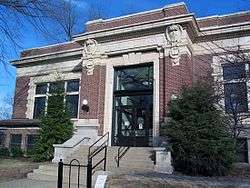Bayard Park Neighborhood
The Bayard Park Neighborhood is a neighborhood in Evansville, Indiana which is bounded by Lincoln Avenue, US Highway 41, Washington Avenue and Garvin Street. The Bayard Park Historic District contains approximately 87 acres including 335 contributing buildings and 1 contributing site within the neighborhood boundaries. It was added to the National Register of Historic Places in 1985.[1] The architecture of residential homes in the neighborhood include quaint 1890s Queen Anne cottages, ground-hugging bungalows, American Fourquares, and high-style Early American and English revival types.[2] The neighborhood also features Evansville's first neighborhood park and the East Branch Library, a Carnegie Library funded by the renowned philanthropist Andrew Carnegie.
Bayard Park Historic District | |
 The East Branch Library, completed in 1912 and built in the style of Beaux Arts Classicism. | |
  | |
| Location | Roughly bounded by Gum, Kentucky, Blackford and Garvin Sts., Evansville, Indiana |
|---|---|
| Coordinates | 37°57′57″N 87°33′0″W |
| Area | 87 acres (35 ha) |
| Architect | Anderson & Veatch; Multiple |
| Architectural style | Bungalow, Craftsman, Late Victorian, Carpenter Cottage |
| NRHP reference No. | 85001373[1] |
| Added to NRHP | June 27, 1985 |
History
The Bayard Park enclave took root in the last decades of the 19th century as the city of Evansville expanded eastward. The area's future as a residential area was determined when various owners of the land determined in 1893 to prohibit, via recorded plan restrictions, any type of commerce in their respective subdivisions. This made the neighborhood the first planned land development in Evansville.[3]
By 1897, the area had been annexed into Evansville which brought with it city amenities like water and sewer lines, and the erection of a public school. As the 20th century commenced, the city's middle class moved heavily into the area, with the period of 1905 to 1915 one of intense development. By the beginning of the Great Depression, the residential district was fully established.
Demographics
Like many urbanized neighborhoods, Bayard Park has undergone significant demographic changes over the years. In 2009 about 22.9% of the residents in the historic district of the neighborhood lived below the Poverty line, compared with 13.7% in the city as a whole.[4]
Bayard Park
Bayard Park, located within the neighborhood and giving the district its name, was Evansville's first neighborhood preserve. The ten acre tract was donated in 1901 to the city for perpetual park use by Mrs. Martha Orr Bayard (1836-1909). The gift was made on the condition that the park be named after her late husband, banker Samuel Bayard, and that she be allowed to landscape it; however, she further stipulated that the City was to provide maintenance.
References
- "National Register Information System". National Register of Historic Places. National Park Service. July 9, 2010.
- A Stroll Through the Bayard Park Neighborhood. The City of Evansville. 1990.
- "Indiana State Historic Architectural and Archaeological Research Database (SHAARD)" (Searchable database). Department of Natural Resources, Division of Historic Preservation and Archaeology. Retrieved 2016-08-01. Note: This includes Joan Marchand (September 1984). "National Register of Historic Places Inventory Nomination Form: Bayard Park Historic District" (PDF). Retrieved 2016-08-01. and Site map
- "Bayard Park Historic District neighborhood". City-Data.com.

